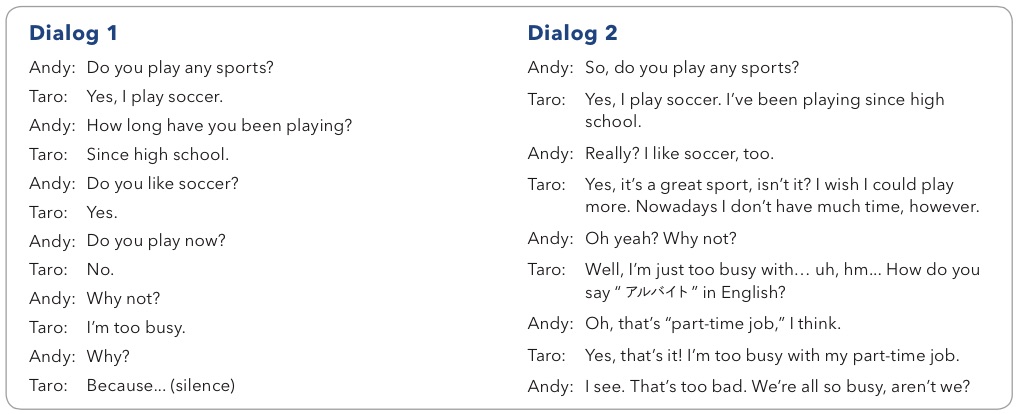The Golden Rules
The three Golden Rules were devised to help your students overcome three key cultural differences in speaking styles. The first rule deals with how silence is interpreted in conversation. The second focuses on answer length, and the third is concerned with patterns of turn-taking. All three rules are based on principles drawn from the linguistic field of pragmatics, which is the study of social language use, or “the secret rules of language”. As noted researcher Bardovi-Harlig puts it, “L2 pragmatics is the study of how learners come to know how-to-say-what-to-whom-when.”
Golden Rule 1: When asked a question, don’t remain silent for more than a few seconds.
Golden Rule 2: Give longer answers by adding one or two extra pieces of information.
Golden Rule 3: It’s natural to sometimes talk about yourself.
In a nutshell, the Golden Rules are about teaching students how to come across as friendly and interactive when speaking in English. To get a sense of their importance, students are invited to feel the difference they make by reading aloud the following dialogs on page 9:

Transcript of audio track 1-4
In Dialog 1, you probably noticed that while Taro’s English was correct, he didn’t sound friendly. His answers were short, and he never spoke about himself except when answering a question. At the end he remained silent because he did not know how to say what he wanted to say. If this conversation had taken place in Japanese, it wouldn’t have been so shocking. In Japanese, it’s often okay to sound hesitant and let your partner lead by asking many questions, especially if that person is of higher status, older, or doesn’t know you well. However, in English, speaking in this way makes you come across as uninterested and uncooperative.
In Dialog 2, Taro gave longer answers, volunteered information about himself, and found a way to avoid long silences. His conversation partner, Andy, found it easier to get the conversation going and ended up having a positive impression of Taro.
Now, is the speaking style in Dialog 2 always better than the one in Dialog 1? Not necessarily. Each way is appropriate for its culture. Saying one way is better than the other at all times is like saying that driving on the right side of the street is best in all countries. All cultures have their own particular ways of doing things. When you speak a different language, you are temporarily in that language’s world, a world often governed by a different set of rules, or “cultural codes”.
Our cultural habits are very deep and largely unconscious, so you’ll have to practice a lot in order to be able to apply English cultural codes when it matters, during real-time conversations outside of the classroom. On the following pages, you can look forward to a more detailed explanation of a few key differences between English and Japanese communication styles and how to overcome them. These solutions are so important that we have called them the “Three Golden Rules of English Conversation.”
Dialog 1では、太郎は正しい英語を使って話しているのに、どこかつっけんどんな印象を与えてしまっています。彼の答えがいつも短くて質問されたことだけにしか答えず、自分のことを進んで話そうとしていないからです。そして最後には、彼は言いたいことをどう伝えてよいか分からず、黙り込んでしまいました。これがもし日本語での会話なら、会話としてそれほどおかしくはなかったかもしれません。日本語では、特に目上の人や自分のことをよく知らない人と話すときには、遠慮がちに話し、相手がどんどん質問するというスタイルも珍しくないからです。しかし、これが英語の場合、このような答え方をしていると無愛想で気むずかしい人だという印象を与えかねないのです。
次に、Dialog 2はどうでしょうか?太郎は相手に長い答えで返し、自分のことを進んでどんどん話し、長い沈黙を避けるようにしています。そうすることで、会話の相手アンディーは会話を続けやすくなり、太郎に対して好印象を持ったのです。
では、Dialog 2の会話スタイルの方がいつもDialog 1のものよりも優れていると言えるのでしょうか?いいえ、必ずしもそうとは限りません。それぞれの文化に適した会話スタイルがあるからです。交通ルールに例えれば、欧米諸国が右側通行であるのに対し日本などの国が左側通行であるように、各国に合った独自のスタイルというものがあるのです。外国語を話すときにも同様のことが言えます。その国の語を話すときには、その文化や会話のマナーに従って話す必要があるのです。
生まれ育った文化に根ざした習慣やマナーというのは、思いの外根深いものです。英会話のマナーを身につけ、それを自在に使いこなせるようになるまでには、授業中だけではなくクラスの外でも何度も練習を繰り返す必要があるでしょう。次のページでは、英語と日本語の会話スタイルの違いを更に詳しく説明し、その対処法も示しているので確認していきましょう。この会話スタイルの違いに対する解決策は非常に重要なので、「英会話のゴールデン・ルール」と呼んでいます。
AUDIO TRACKS + TRANSCRIPTS
♪ 1-4 (p.9)
| Dialog 1では、太郎の英語は文法としては間違っていないのに、どこかつっけんどんなかんじがすることに気づいたのではないでしょうか。答えはいつも簡潔で短く、質問されない限りは自分のことを進んで話そうとはしていません。最後には、英語でどう説明したらいいかが分からず、黙り込んでしまいました。これがもし日本語での会話なら、それほどおかしくはなかったかもしれません。日本語では、特に目上の人や年上の人、よく知らない人と話すときには、敢えてでしゃばったりせずに、相手に質問されるのに任せるのも珍しくないからです。しかし、英語でも同じようにしてしまうと、無愛想で気むずかしい人だという印象を与えてしまいます。 | In Dialog 1, you probably noticed that while Taro’s English was correct, he didn’t sound friendly. His answers were short, and he never spoke about himself except when answering a question. At the end he remained silent because he did not know how to say what he wanted to say. If this conversation had taken place in Japanese, it wouldn’t have been so shocking. In Japanese, it’s often okay to sound hesitant and let your partner lead by asking many questions, especially if that person is of higher status, older, or doesn’t know you well. However, in English, speaking in this way makes you come across as uninterested and uncooperative. |
| 次に、Dialog 2をみてみましょう。太郎はより長い答えを返していますし、聞かれたこと以外にも進んで話を広げています。長く黙り込まないようにも気をつけています。アンディとしてはこの方がずっと話しやすいですし、太郎に対してもいい印象を持つことができたはずです。 | In Dialog 2, Taro gave longer answers, volunteered information about himself, and found a way to avoid long silences. His conversation partner, Andy, found it easier to get the conversation going and ended up having a positive impression of Taro. |
| では、Dialog 2の会話スタイルの方がいつもDialog 1のものよりも優れていると言えるのでしょうか?もちろんそうとは限りません。それぞれの文化に適した会話スタイルというものがあるからです。いずれかの会話スタイルだけが他よりも優れているなどと言うのは、世界中どこの国でも車は右側通行するのが正しいと言うようなものです。文化が違えば物事のやり方も違って当たり前なのです。よって、違う言葉を話すときには、一時的に違う文化圏にいるのだと考えてみましょう。そこでは、自分の文化とは違うルールで物事が動いていくのです。 | Now, is the speaking style in Dialog 2 always better than the one in Dialog 1? Not necessarily. Each way is appropriate for its culture. Saying one way is better than the other at all times is like saying that driving on the right side of the street is best in all countries. All cultures have their own particular ways of doing things. When you speak a different language, you are temporarily in that language’s world, a world often governed by a different set of rules, or “cultural codes”. |
| 生まれ育った文化に根ざした習慣やマナーはとても根深く、その大部分が意識されることすらありません。英会話のマナーを身につけ、クラス以外の実生活でも使えるようになるまでには、何度も練習を繰り返す必要があるでしょう。このセクションでは、引き続き英語と日本語の会話スタイルの違いを詳しくみていきます。対処法も同時に学んでいきましょう。この対処法は非常に重要なので、このテキストでは「英会話のゴールデン・ルール」と呼んでいます。 | Our cultural habits are very deep and largely unconscious, so you’ll have to practice a lot in order to be able to apply English cultural codes when it matters, during real-time conversations outside of the classroom. On the following pages, you can look forward to a more detailed explanation of a few key differences between English and Japanese communication styles and how to overcome them. These solutions are so important that we have called them the “Three Golden Rules of English Conversation.” |